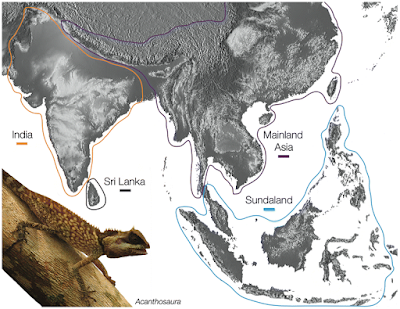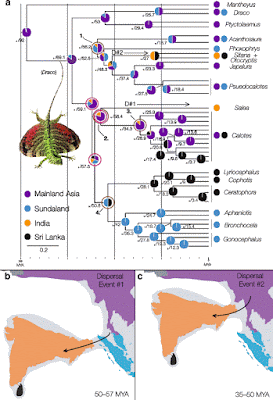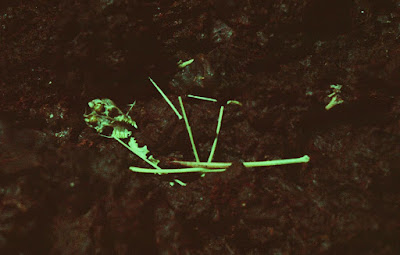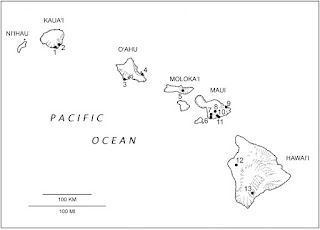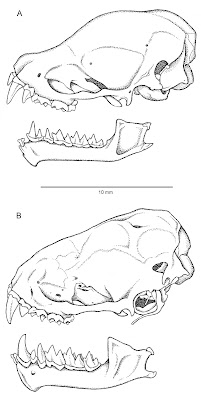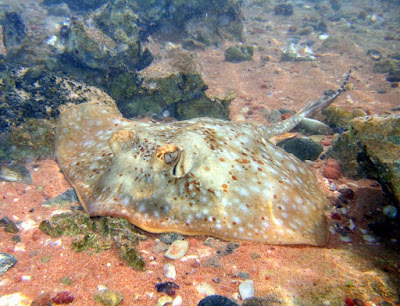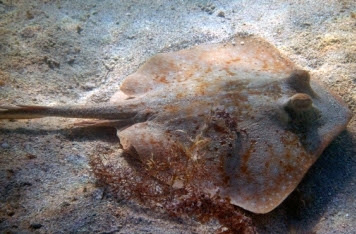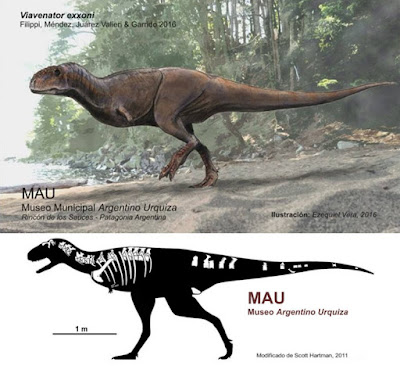[Most Recent Entries] [Calendar View]
Tuesday, March 29th, 2016
| Time | Event | ||||
| 1:44p | [Herpetology • 2016] The Eurasian Invasion: Phylogenomic Data reveal Multiple Southeast Asian Origins for Indian Dragon Lizards
Abstract Background The Indian Tectonic Plate split from Gondwanaland approximately 120 MYA and set the Indian subcontinent on a ~ 100 million year collision course with Eurasia. Many phylogenetic studies have demonstrated the Indian subcontinent brought with it an array of endemic faunas that evolved in situ during its journey, suggesting this isolated subcontinent served as a source of biodiversity subsequent to its collision with Eurasia. However, recent molecular studies suggest that Eurasia may have served as the faunal source for some of India’s biodiversity, colonizing the subcontinent through land bridges between India and Eurasia during the early to middle Eocene (~35–40 MYA). In this study we investigate whether the Draconinae subfamily of the lizard family Agamidae is of Eurasian or Indian origin, using a multi locus Sanger dataset and a novel dataset of 4536 ultraconserved nuclear element loci. Results Results from our phylogenetic and biogeographic analyses revealed support for two independent colonizations of India from Eurasian ancestors during the early to late Eocene prior to the subcontinent’s hard collision with Eurasia. Conclusion These results are consistent with other faunal groups and new geologic models that suggest ephemeral Eocene land bridges may have allowed for dispersal and exchange of floras and faunas between India and Eurasia during the Eocene. Keywords: Agamidae, Draconinae, Eocene, Eurasia, India, Faunal exchanges, Landbridges Conclusions The use of additional taxa, sequence-capture data, and newer geological models—all data not available to previous studies on Draconinae—resulted in novel and well-resolved relationships, leading to new biogeographic insights in this unique subfamily of lizards. Using these biogeographic insights and a broad comparison with previous biogeographic literature, we propose the Eocene Exchange Hypothesis, and the simple but well supported assumption that land bridges may have facilitated a broad-scale pattern of faunal exchange between the ISC and areas of Eurasia before its collision with Asia during the Eocene. We expect that with additional sampling of Indian and mainland Asian species, some factors that may have biased our biogeographic interpretations within the Draconinae to (i.e., Indian extinction events), can be evaluated. In addition, sampling of additional draconine species will allow us to test more fine-scaled hypotheses concerning dispersal and diversification within this group. Our phylogenomic analysis add to a growing body of knowledge addressing the effects of the ISC’s collision on biogeography and offers new ideas to be tested by future studies. Jesse L. Grismer, James A. Schulte II, Alana Alexander, Philipp Wagner, Scott L. Travers, Matt D. Buehler, Luke J. Welton and Rafe M. Brown. 2016. The Eurasian Invasion: Phylogenomic Data reveal Multiple Southeast Asian Origins for Indian Dragon Lizards. BMC Evolutionary Biology. DOI: 10.1186/s12862-016-0611-6 Land bridges linking ancient India and Eurasia were 'freeways' for biodiversity exchange http://phy.so/378047593 via @physorg_com | ||||
| 2:27p | [Mammalogy • 2016] Synemporion keana • A Second Endemic Land Mammal for the Hawaiian Islands: A New Genus and Species of Fossil Bat (Chiroptera: Vespertilionidae)
Abstract Located over 3800 km from the nearest continent, the Hawaiian Islands have previously been thought to support only one endemic land mammal, the extant Hawaiian hoary bat (Lasiurus cinereus semotus), a taxon that apparently initially dispersed from mainland North America between 10,000 and 7000 years ago. Some uncertainty exists regarding the status of this taxon (i.e., whether or not populations representing more recent invasions of L. cinereus from North America are exchanging genes with the older lineage, and whether or not semotus represents a distinct species), but all researchers agree that hoary bats are the only endemic land mammals extant in the islands today. However, fossil evidence indicates that the Hawaiian Islands once supported another quite different endemic bat species that is now extinct. Skeletal remains of a new genus and species of vespertilionid bat are herein described from various Late Pleistocene and Holocene/Recent deposits on the five largest Hawaiian Islands. The new taxon is diagnosed by a mosaic of features including dental formula, molar morphology, skull shape, and metacarpal formula. This new taxon, which is smaller than Hawaiian hoary bat, was apparently present in the Hawaiian Islands by 320,000 years b.p. and survived until at least 1100 years ago and possibly much later. Accordingly, two species of bats coexisted on the Hawaiian Islands for several thousand years. As with numerous extinct endemic bird species, the extinction of the new bat taxon described here may have resulted either directly or indirectly from human colonization of the islands and the invasive nonnative species that came with human explorers and settlers. Family Vespertilionidae Gray, 1821 Synemporion keana, gen. and sp. nov. Lava-tube Bat Type Locality: Hawaiian Islands, Maui Island, ‘Ulupalakua Ranch, Māhiehie Cave, 500 m, 20.63°N; 156.39°W (WGS 84 datum). Geographic and Geologic Range: Hawaiian Islands, at least the five largest islands, from ca. Middle Pleistocene to Late Holocene (but apparently not into post-1778 historic period), with details as follows. Kaua‘i: infill of sinkhole of Late Pleistocene lithified calcareous dune deposits, and in Early Holocene eolian surface calcareous sand-dune deposits; O‘ahu: in Middle Pleistocene pond deposits of volcanic tuff-cone crater, as well as in later-Pleistoceneto-Holocene composite soil deposits (primarily sedimentary) within limestone sinkholes in emergent Late Pleistocene coral-algal reefs; Moloka‘i: in presumably Polynesian or early postcontact alluvial sediment on floor of a dynamically active piping cave; Maui: on exposed floor, embedded in mineralized crusts on walls and in alluvial sediments of Late Pleistocene or Holocene lava tubes; Hawai‘i: on exposed floor or in alluvial deposits of Late Pleistocene and Holocene lava tubes; approximate locations of these sites are shown in figure 1, and detailed information on all sites is provided in appendix 4.
Etymology: The genus name Synemporion root from Greek common noun synemporos, “fellow traveler or companion,” with addition of the suffix -ion to form a neuter diminutive, in allusion to the new bat’s former co-occupation of the tectonically mobile Hawaiian Islands with the larger Lasiurus cinereus semotus. The specific name is a noun in apposition, formed from Hawaiian: the demonstrative ke, plus ana, “cave” or “lava tube,” referring to the subterranean provenience of the holotype and a majority of the paratypes. Alan C. Ziegler, Francis G. Howarth and Nancy B. Simmons. 2016. A Second Endemic Land Mammal for the Hawaiian Islands: A New Genus and Species of Fossil Bat (Chiroptera: Vespertilionidae). American Museum Novitates. digitallibrary.amnh.org/handle/2246/6641 Discovery of extinct bat doubles diversity of native Hawaiian land mammals http://bit.ly/1RdWUUG via @amnh @EurekAlertAAAS | ||||
| 2:37p | [Ichthyology • 2010] Neotrygon ningalooensis • A New Maskray (Myliobatoidei, Dasyatidae) from Australia
Abstract A new maskray, Neotrygon ningalooensis n. sp., is described from material collected near Coral Bay in the Ningaloo Marine Park, off the central coast of Western Australia, where its distribution appears to be restricted and patchy. However, other recently accessed material, collected further south (Shark Bay, Western Australia) and east (Gove, Northern Territory), suggest that this species is more widespread. Like other members of the genus Neotrygon, it lives primarily on sandy substrates but often hides partly concealed beneath small coral bommies during the day. Its eyes are relatively more protrusible than its congeners enabling it to bury deeply in soft sediments with its eyes still exposed. The type specimens were speared in shallow water near the shore in close association with two congeners, N. leylandi and N. kuhlii, from which it differs in colour and morphology. Neotrygon ningalooensis and N. leylandi both have an ornate dorsal coloration but lack the vivid blue spots typical of N. kuhlii. Molecular analysis has confirmed that the three sympatric species at Ningaloo are specifically distinct. Peter R. Last, William T. White and Melody Puckridge. 2010. Neotrygon ningalooensis n. sp. (Myliobatoidei, Dasyatidae), A New Maskray from Australia. aqua: International Journal of Ichthyology. 16(2): 37–50. | ||||
| 2:40p | [Paleontology • 2016] Viavenator exxoni • A New Brachyrostran with Hypertrophied Axial Structures reveals An Unexpected Radiation of Latest Cretaceous Abelisaurids Abstract A well preserved skeleton of a new abelisaurid is reported here. The holotype of Viavenator exxoni was found in the outcrops of the Bajo de la Carpa Formation (Santonian, Upper Cretaceous), northwestern Patagonia, Argentina. This new taxon belongs to the South American clade of abelisaurids, the brachyrostrans. The current phylogenetic analysis places it as the basalmost member of a new clade of derived brachyrostrans, named Furileusauria, characterized by distinctive cranial, axial and appendicular anatomical features. The Santonian age of Viavenator allows filling the stratigraphic gap exhibited between the basal brachyrostrans of Cenomanian–Turonian age, and the derived forms from the Campanian-Maastrichtian. The evolution of abelisaurids during the Late Cretaceous, faunal replacements, and the adaptive radiation that occurred during that period of time in South America are discussed. Keywords: Abelisauridae; Brachyrostra; Furileusaira; Bajo de la Carpa; Upper Cretaceous; Neuquén Basin Systematic paleontology Theropoda Marsh, 1881 Ceratosauria Marsh, 1884 Abelisauridae Bonaparte & Novas, 1985 Brachyrostra Canale et al., 2009 Furileusauria clade nov. Derivation of name. From Mapudungun language ‘Furileu’ stiff back, and Greek language ‘sauria’ lizard, in reference to the extreme level of stiffness in their axial skeletons. Definition. The most inclusive clade containing to Carnotaurus sastrei but not Ilokelesia aguadagrandensis, Skorpiovenator bustingoryi or Majungasaurus crenatissimus. Diagnosis. Furileusauria differs from all other brachyrostrans and other abelisaurids in the (1) presence of a tip in the middle area of the posterior surface of the ventral process of the postorbital, (2) presence of a knob followed by a deep notch in the postorbital-squamosal contact, (3) absence of fenestra between the frontal, postorbital and lacrimal, (4) anterior projection of the distal end of cervical epiphophyses, (5) posterior margin of the postzygapophyses at level with the intervertebral articulation in dorsal vertebrae, (6) crescent-shaped morphology of the distal tip of the transverse processes in anterior and middle caudal vertebrae, (7) transverse processes of anterior caudal vertebrae distally expanded and only anteriorly projected, (8) convex external margin of the transverse processes in the anterior caudals, (9) and cnemial crest of the tibia with a downturned process. Included species. Viavenator exxoni, Carnotaurus sastrei, Abelisaurus comahuensis, Aucasaurus garridoi, Quilmesaurus curriei, Pycnonemosaurus nevesi. Viavenator exxoni gen. et sp. nov. Derivation of name. From latin ‘Via’ road, and ‘venator’ hunter, meaning the hunter of the road, ‘exxoni’ is in recognition of Exxonmobil's commitment to the preservation of paleontological heritage of the La Invernada area, Rincón de los Sauces, Neuquén, Patagonia Argentina. Holotype. MAU-Pv-LI-530. Type locality. La Invernada area ( Fig. 1), located 50 km southwest from the Rincón de los Sauces city, Neuquén province, Patagonia, Argentina. Stratigraphic horizon. Bajo de la Carpa Formation, Río Colorado Subgroup, Neuquén Group of the Neuquén basin. Santonian, Upper Cretaceous. The continental deposits of this lithostratigraphic unit have provided scant evidence relative to theropod dinosaurs. Small-sized forms include the noasaurid Velocisaurus unicus and the alvarezsaurids Alvarezsaurus calvoi and Achillesaurus manazonnei ( Bonaparte, 1991a and Martinelli and Vera, 2007). Mid and big sized theropods include a tetanuran possibly related to Carcharodontosauridae or Megaraptora (Porfiri et al., 2008) and indeterminate abelisaurid materials previously referred as Carnotaurines ( Ezcurra and Méndez, 2009 and Porfiri and Calvo, 2006), some of these found in the La Invernada area (see below). Concluding remarks In the present paper, we describe a new abelisaurid theropod from the Santonian of Patagonia, Argentina. The new form is here named Viavenator exxoni gen. et sp. nov., and possesses, among other characteristics, hypertrophied structures in the presacral axial skeleton. Based in our phylogenetic analysis, Viavenator is found as a transitional brachyrostran, as the oldest member of a late radiation clade of the South American forms, named Furileusauria, and includes all the currently known abelisaurid taxa of this continent found in Santonian to Maastrichtian strata. The assemblages are found in a more complex biogeographic scenario with a division among European and Indo-Malagasy majungasaurines , with possible basal brachyrostrans in India and Madagascar. Here we interpret that the furileusarians are supporting evidence of a late radiation of brachyrostran abelisaurids that fit with a faunal replacement that happened during the Turonian in South America, and is concordant with other dinosaur clades as the carcharodontosaurians, rebbachisaurids and derived lithostrotians. Filippi, LS, Méndez, AH, Juárez Valieri, R. & Garrido, AC. 2016. A New Brachyrostran with Hypertrophied Axial Structures reveals An Unexpected Radiation of Latest Cretaceous Abelisaurids. Creataceous Research. 61:209-219. DOI: 10.1016/j.cretres.2015.12.018 El MAU ya tiene su primer dinosaurio terópodo Ya se encuentra publicado en versión online, en la revista Cretaceous Research, el trabajo sobre este dinosaurio carnívoro, un nuevo abelisaurio, que proviene de La Invernada de rocas de la Formación Bajo de la Carpa. La excelente preservación y la significativa información que aportó el ejemplar resultaron relevantes para avanzar en el conocimiento de este grupo de terópodos, los abelisaurios. Viavenator ("cazador del camino") exxoni gen. et sp. nov. es el primero dado a conocer de una serie de ejemplares que han sido recuperados en la zona de La Invernada gracias al enorme apoyo de la empresa Exxonmobil. Desde la Dirección del MAU se espera a futuro, poder llevar a delante una presentación formal del nuevo dinosaurio. Museo Argentino Urquiza MAU - Oficial |
| << Previous Day |
2016/03/29 [Calendar] |
Next Day >> |
